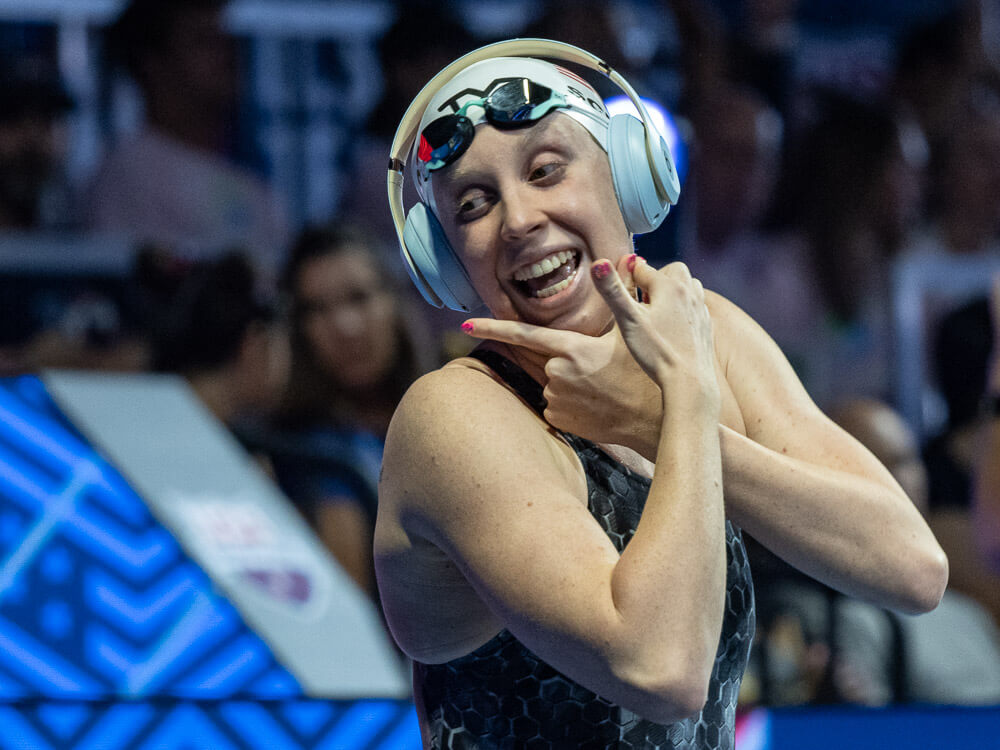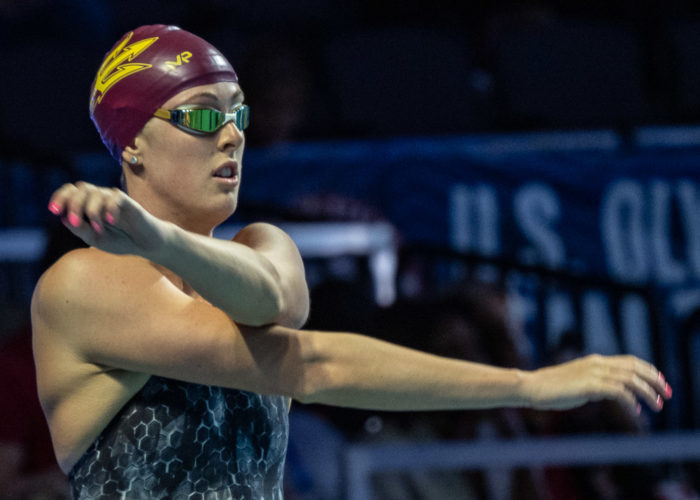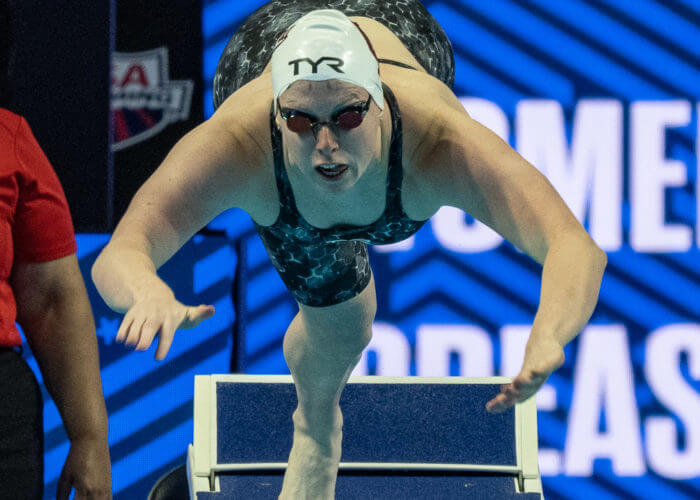The Pre-Race Rituals Witnessed at the U.S. Olympic Trials

The Pre-Race Rituals Witnessed at the U.S. Olympic Trials
By Annika Hobson, Swimming World College Intern
While watching the United States’ Olympic Trials, I observed that most of the athletes have specific pre-race rituals. Pre-race rituals are beneficial as they allow a swimmer to collect themselves and focus. Pre-race routines can also be a way for the swimmer to get pumped up and excited prior to their race. Watching the elite swimmers before their races revealed that there are many ways to prepare for a race and that each swimmer has their own approach.
Stretching

Photo Courtesy: Peter H. Bick
A classic component to pre-race rituals, stretching warms up the swimmer’s muscles to be ready for a fast race. A stretching routine not only prepares a swimmer’s body but mentally prepares them for the race ahead. Having a consistent, behind-the-blocks stretching routine provides the swimmer with something to focus on before a nerve-racking event. For example, a vital part to Allison Schmitt’s pre-race routine is stretching her arms and shoulders. The now four-time Olympian takes her time to make sure her body is loose and ready for a competitive race.
Jumping
Another common component of pre-race rituals is jumping. Jumping is great for preparing a swimmer for a race by getting their blood flowing. There are a variety of ways to jump before a race from jumping jacks to bouncing up and down to giant tuck jumps. A perfect example of a pre-race jumper is Andrew Wilson. Wilson has massive hops as he backs away from the blocks to do a giant tuck jump before his race.
Dancing
A rarer form of a pre-race ritual, dancing can help to lessen nerves and loosen up the body. While this is not the most common form of getting ready for a race, dancing sure makes a statement. Sierra Schmidt’s pre-race ritual involves highly energetic dances. Schmidt’s dances prepare her for her race and draw the fans’ attention toward her unique routine.
Still Focus
In the opposite direction of pre-race dancing, many athletes choose to be still and focused. This pre-race ritual can involve focusing on one’s breath, running through the race in one’s mind, and mentally preparing for the upcoming race. If a spectator closely watches Katie Ledecky, they can see her take a few deep breaths while she waits to get up on the blocks. Ledecky’s breaths center her and prepare her for her race. Another swimmer that is immensely focused before a race is Torri Huske. Huske rushes to take off her parka and then becomes incredibly still with one leg on the block. Huske’s stillness allows her to push away any distractions and focus on her own race.
Clapping/Slapping

Photo Courtesy: Peter H. Bick
Another popular element to pre-race routines is clapping and/or slapping. Especially before sprint events, you can hear persistent slaps as swimmer’s get their blood flowing. Slapping alerts the muscles to be prepared for a fast twitch start. Similarly, clapping activates nerves in the hands to prepare the swimmers to have a good feel of the water. Prior to diving in the pool, Lilly King utilizes the slapping technique by slapping her thigh. King enjoys making the loud noise and it is a key part to her pre-race routine. Another example lies in Jake Mitchell as he slapped his chest as part of his pre-race routine prior to swimming his impressive 400 freestyle time trial.
Arm Swings
Yet another common element to pre-race routines, arm swinging helps to loosen up the muscles. Arm swings are great for making a swimmer feel less tense before a big race. There are many ways to perform arm swings, such as mimicking strokes and the iconic Michael Phelps cross over arm swing. In the leadup to the 800 freestyle final, one could see Erica Sullivan swinging her arms as part of her pre-race warmup.
Last-Minute Capping
While most pre-race routines leave swimmers feeling less tense and more relaxed, the last-minute capper seems somewhat frazzled. The majority of swimmers walking out to a final race already have their caps and goggles on; thus, the last-minute capper likes to feel an extra rush of adrenaline. Before each of his races, Trenton Julian hurries to put on his cap(s). Watching the last-minute capper leaves the onlooker relieved as it is a stress inducing pre-race ritual.
From Lilly King intimidating her competitors with her loud slapping, to Katie Ledecky’s quiet focus, there are many ways to prepare for a big race. Especially in a pressure filled arena, such as the Olympic Trials, it is important to have a routine that works for each swimmer. Make sure to watch athletes not only in the pool, but behind the blocks to see how your favorite swimmers prepare for tough races.
All commentaries are the opinion of the author and do not necessarily reflect the views of Swimming World Magazine nor its staff.



